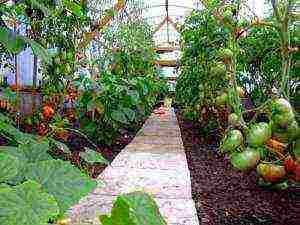Content
- 0.1 CROP AREAS
- 0.2 COLLECTION OF OPEN AND CLOSED TOMATOES
- 0.3 CONSUMPTION OF TOMATOES
- 0.4 IMPORT AND EXPORT OF TOMATOES
- 0.5 INDUSTRY PERSPECTIVES
- 1 20 businesses you can start in your garage
- 2 20 types of business for retirees
- 3 Greenhouse business plan for growing greenery
- 4 Business plan for growing cherry tomatoes indoors
- 5 Pea market overview in Russia
- 6 Overview of the grain corn market in Russia
- 7 The art of merchandising: how to sell fruits and vegetables beautifully
- 8 Instant popularity. How to make a fortune on potato salads and trinkets
- 9 Ideal greenhouse for tomatoes
- 10 Pros and cons of business
- 11 Choosing a variety for closed ground
- 12 Greenhouse equipment
- 13 How to calculate profitability?
- 14 Pros and cons of business
- 15 Where to start: a business plan for growing tomatoes in a greenhouse
- 16 How much can you earn?
- 17 Required start-up capital
- 18 Important issues related to business registration
- 19 Which varieties should you choose?
- 20 Greenhouse tomato cultivation technology for sale
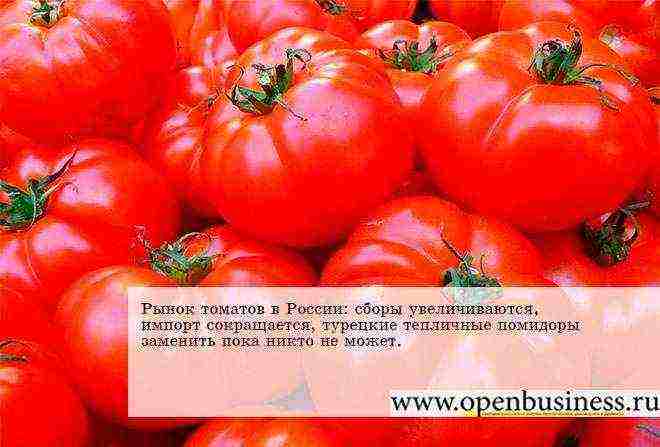
The Russian tomato market is characterized by a low level of self-sufficiency. Most of our own production is the cultivation of tomatoes in the open field. The gross harvest of tomatoes in open ground is more than 80%, while that of tomatoes in greenhouses is less than 20%. At the moment, domestic agricultural producers cannot provide the country with greenhouse products in the off-season, meeting the needs of the population by only a quarter. As a result, in the Russian market, despite the measures taken to substitute imports, imports play a significant role.
CROP AREAS
Rosstat statistics indicate that in the period from 2005 to 2015. The sown area for growing tomatoes in open ground in Russia in all types of farms remains approximately at the same level and, according to the latest data, is 119 thousand hectares. An exception was 2007, when 104 thousand hectares were planted for tomato crops. The decrease in the number of sown areas is most noticeable in comparison with the indicators of 15 years ago, when about 141 thousand hectares were involved in growing tomatoes.
Figure 1. Sown area for open ground tomatoes in Russia, 1997-2015, thousand hectares
The main share of the cultivated area under open ground tomatoes in Russia (over 86%) falls on the non-market sector, i.e. tomatoes that are grown by the population for personal consumption. The joint share of agricultural enterprises, peasant farms and individual entrepreneurs is only 14%. Since 2011, the area of the industrial sector has decreased by 5 thousand hectares (-24%), since 2001 - by 11 thousand hectares (-46%).
Figure 2. Sown areas for open ground tomatoes in Russia by type of farms, 1997-2015, thousand hectares
In terms of the cultivated area for tomatoes, Russia ranks 8th in the world. Most of the territory for these purposes is involved in China, India and Nigeria - there are areas of 1001 thousand hectares, 882 thousand hectares and 541.8 thousand hectares, respectively. They are followed by Turkey (319.1 thousand hectares), Egypt (214 thousand hectares), the USA (163.4 thousand hectares) and Iran (159.1 thousand hectares), one of the main suppliers of greenhouse tomatoes to Russia. ...
Profitable franchises
Figure 3. Leading countries by the number of sown areas for tomatoes, 2014, thousand hectares
COLLECTION OF OPEN AND CLOSED TOMATOES
Compared to other large countries of the world, the volumes of tomato harvest in Russia, for various reasons, are not so large. China is the world leader in tomato harvest. According to the latest FAO data, almost 53 million tons are collected in this country per year. The leaders also include India (18.7 million tons), the USA (14.5 million tons), Turkey (11.8 million tons).tons) and Egypt (8.3 million tons).
Figure 4. Leading countries in tomato harvest (2014), thousand tons
The gross harvest of tomatoes in Russia is 2839 thousand tons, of which 2282 thousand tons fall on the collection of open ground tomatoes (80.4%), 557 thousand tons (19.6%) - on the collection of open ground tomatoes. Compared to 2014, the gross harvest of tomatoes in Russia increased by 20 thousand tons (+ 0.7%), compared to the indicators of five years ago - by 401 thousand tons (+ 16.4%).
Figure 5. Gross harvest of tomatoes in open and closed ground in Russia, 2011-2015, thousand tons
The highest growth rates are observed in the collection of greenhouse tomatoes. So, relative to 2014, the increase was 7.3%, and relative to 2011 - 135%. That is, in five years, the production of greenhouse tomatoes in the country has more than doubled. However, most of the harvests of indoor tomatoes in the country (60%) still fall on the harvest of the population. The share of agricultural organizations and farms is 223 thousand tons, or 40% of the total production of indoor tomatoes.
Profitable franchises
Despite the decrease in the sown area, in Russia there is also a tendency to increase the gross harvest of tomatoes in open ground. Since 2011, tomato harvest in all types of farms has increased by 81 thousand tons (+ 3.7%), since 2006 - by 355 thousand tons (+ 18.4%), since 2001 - by 568 thousand tons ( + 33.1%). As for the commodity sector, growth is also recorded here, while its rates are more significant - since 2011, gross receipts have increased by 5.2%, since 2006 - by 20.8%, since 2001 - (+ 66.3% ). Experts associate the increase in yield primarily with the introduction of drip irrigation technology for growing tomatoes.
Figure 6. Gross harvest of tomatoes in open ground in Russia, 1997-2015, thousand tons
Figure 7. Gross harvests of tomatoes in open ground in Russia by types of farms, 1997-2015, thousand tons
CONSUMPTION OF TOMATOES
In 2015, tomato consumption in Russia decreased by 4.7% compared to 2014. The main reasons for this can be called a decrease in incomes of the population and the imposition of an embargo against the largest supplier of tomatoes - Turkey. Per capita consumption of tomatoes decreased by 6.4%, amounting to 23.9 kg per year.
Figure 8. Dynamics of consumption of tomatoes in Russia, 2013-2015, thousand tons
IMPORT AND EXPORT OF TOMATOES
In the past few years, tomato imports have shown a steady downward trend against the background of the weakening of the ruble and the adopted course of import substitution. This fact has a positive effect on the investment attractiveness of the greenhouse business, but at the same time, it negatively affects the supply of imported seeds for sowing, which are not produced in Russia, as well as some types of materials and equipment.
Today, imports account for about 24% of the Russian market. In 2015, Turkey was the leader in import supplies (more than 52% of imports), which traditionally sent greenhouse tomatoes to Russia. In 2016, due to the imposition of an embargo on tomatoes from this country, the situation changed. Following the results of nine months of 2016, the main suppliers were representatives of Morocco (88.7 thousand tons) and Azerbaijan (86 thousand tons), which added 158% and 56% in supplies to our country, respectively. However, other countries could not replace Turkey - the overall drop in imports in the third quarters of 2016 was 32% (365 thousand tons).
Figure 9. Imports of fresh and chilled tomatoes of all types to Russia, 2005-2016 (Sept.), Thousand tons
Figure 10. Imports of fresh and chilled tomatoes to Russia, 2005-2016 (Sept.), Thousand dollars
The export of tomatoes from Russia is insignificant, although in 2015 it increased significantly and amounted to 11,750 tons. However, this growth can rather be called episodic, which is confirmed by the data of the Federal Customs Service of Russia. Here we are talking about one-off transactions, and export volumes are measured not in millions, but only in thousands of dollars.
Figure 11. Export of fresh and chilled tomatoes from Russia, 2005-2016 (Sept.), Thousand dollars
INDUSTRY PERSPECTIVES
The course of import substitution taken by the state should help domestic producers to gain a foothold in the market in the face of reduced imports. It's about growing tomatoes in greenhouses.The increase in the number of open areas seems to be ineffective due to the fact that the demand for tomatoes in August-September (harvesting period) is small, and imports during these months are reduced to a minimum. Earlier, the Ministry of Agriculture of the Russian Federation announced plans to lift the embargo on Turkish vegetables no earlier than in 2-3 years in order to contribute to the development of its own industry for the production of domestic greenhouse products.
Business calculator
Calculate the profit, payback, profitability of any business in 10 seconds.
Enter initial attachments

20 businesses you can start in your garage
For many successful entrepreneurs, the business once began with a garage, which served as a platform for their experiments and first experiments. What types of earnings are suitable for a garage format?

20 types of business for retirees
Elderly people should pay attention to the quietest types of business that either do not require complex processes, or are cheap to start, or make it possible to earn a hobby.

Greenhouse business plan for growing greenery
Growing greenery is a business that you can do on your own site by building a greenhouse on it. He does not promise superprofits, but it is perfect as a side job.

Business plan for growing cherry tomatoes indoors
Business plan for growing cherry tomatoes indoors in the city of Rostov-on-Don. Initial investment - 1,600,000 rubles. Net profit in the first year of operation - 1,038,892 rubles….
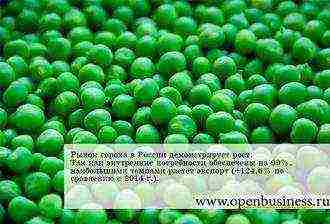
Pea market overview in Russia
The pea market in Russia is showing growth. Since domestic needs are met by 99%, exports are growing the fastest (+ 124.6% compared to 2014).
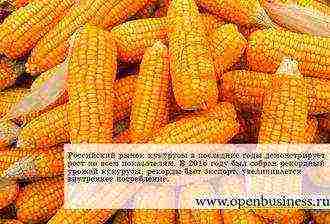
Overview of the grain corn market in Russia
The Russian corn market in recent years has been showing growth in all respects. In 2016, a record corn crop was harvested, exports are breaking records, and domestic consumption is increasing.
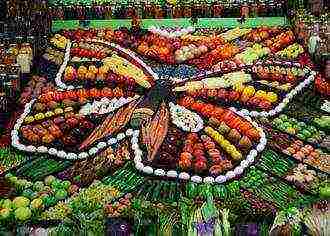
The art of merchandising: how to sell fruits and vegetables beautifully
What sellers of vegetables and fruits do not go to in order to stand out from the background of numerous competitors! And they have a lot to learn: just look at the wonders of merchandising they get up to.

Instant popularity. How to make a fortune on potato salads and trinkets
Big money and worldwide fame can come in minutes. The only question remains where to put your efforts and how to convey your idea to the masses. The heroes of this material did it.
Ideal greenhouse for tomatoes
Summer greenhouses or hotbeds are often installed on personal plots. They are suitable for protecting plants during frosts, accelerate fruiting, allow you to grow especially thermophilic varieties. Such greenhouses can be built on a wooden or metal frame and covered with foil. The greenhouse requires annual renovation, but it is quite cheap. Suitable only for seasonal cultivation in soil.
For year-round cultivation of tomatoes capital buildings are neededequipped with a heating system. Such greenhouses are erected on a solid metal frame with an anti-corrosion coating. Glass or polycarbonate is used as a coating.
The latter is suitable for arched greenhouses, sheets can be bent and cut without fear of damage. In regions with cold climates double glazing recommended... The air between the layers of glass or polycarbonate creates a thermos effect, which helps to reduce heating costs.
For year-round cultivation, a greenhouse with a pitched roof is more convenient. Sizes vary from 100 to 500 sq. m... Industrial greenhouses are even larger, with an average size of about 1000 sq. m.
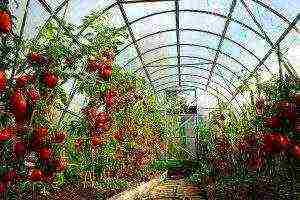 Such structures imply overhead cultivation, hydroponic or aeroponic... A significant disadvantage of tomatoes grown in a nutrient solution is the recognizable watery taste and the absence of a characteristic aroma.
Such structures imply overhead cultivation, hydroponic or aeroponic... A significant disadvantage of tomatoes grown in a nutrient solution is the recognizable watery taste and the absence of a characteristic aroma.
An ideal tomato greenhouse should be tall enough. The north wall can be laid out with cinder blocks or timber. A blank wall will protect the landings from the wind and will help keep warm. The preferred design is with a pitched roof, on which snow does not linger.
Pros and cons of business
Growing tomatoes indoors has many advantages... Among them:
- high demand for tomatoes, increasing in the autumn-winter season;
- heated greenhouses allow for several harvests per year;
- there are many varieties designed specifically for greenhouses;
- tomatoes stored long enoughthat minimizes losses;
- the harvested crop can be sold independently, through retail outlets on the market or the Internet, as well as sold through retail chains, catering and wholesale buyers.
Despite the good prospects for entrepreneurs, business has some drawbacks.
Among the most significant:
- high costs of heating the greenhouse in the cold season;
- growing tomatoes on an industrial scale should only be done by people with experience in plant growing;
- for work with retail registration of a legal entity is required and obtaining a veterinary certificate for products;
- in the summer, competition from the owners of outdoor tomato growers increases.
Choosing a variety for closed ground
In the greenhouse, it is preferable to grow hybrids specially designed for indoor use. It is better to choose tall, branched varieties. On such a bush many fruits ripen at the same time, which increases the productivity of greenhouses. Tall bushes can be combined with smaller ones planted around the perimeter. This arrangement will allow you to make optimal use of the scarce space.
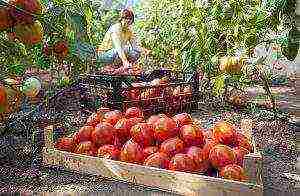 For indoor use, both early and late varieties are suitable. In the middle lane, it is not recommended to plant especially sweet hybrids of southern selection, they are very sensitive to temperature fluctuations and can be affected by pests.
For indoor use, both early and late varieties are suitable. In the middle lane, it is not recommended to plant especially sweet hybrids of southern selection, they are very sensitive to temperature fluctuations and can be affected by pests.
Specialists recommend choosing hybrids, zoned for a specific region. The varieties of Russian selection, as well as American, Dutch and Polish tomatoes, have proven themselves very well.
When choosing the right variety, it is worth considering:
- Yield... Multiple varieties will significantly increase income.
- Fruit ripening time... The shorter the growing season, the more profitable the business.
- Disease resistance... The best hybrids are not affected by pests and do not require constant insecticide treatment.
- Taste qualities of tomatoes... Consumers prefer fleshy fruits with a bright sweetish taste and pronounced aroma.
- Fruit size and color... Tomatoes of medium size, deep red, pink or yellow, are in great demand among buyers.
- It is advisable to choose varieties with fruits that tolerate storage and transportation well.
Among the most popular, industrial varieties of tomatoes for greenhouses can be noted:
- Early and mid-season varieties: Gift, Aksinya, Cherry, Evpator, Kostroma. Palenque.
- Hybrids with a shortened growing season: Verlioka, Rhapsody, Caspar, Sprinter, Etude, Farmer.
- Fruits with a particularly intense taste: Honey Spas, Pink Honey, Orange King, Asteroid, Lady, Ballerina.
Other tomato varieties recommended for greenhouses presented on our website:
ChocolateQishmishYellow pearDomes of RussiaPride of SiberiaPink ImpressionNewbieWonder of the WorldPresident 2De Barao GiantMeaty handsome
.
Having chosen the right variety, it is worth concentrating on it. Industrial cultivation of tomatoes in a greenhouse not focused on experimentation, but to increase yields.Professionals usually grow no more than 2-3 types of tomatoes at a time.
Greenhouse equipment
In small farm greenhouses, it is better to grow tomatoes in the ground. Their taste is much higher, which makes it possible to sell products at a good mark-up.
Greenhouse must be equipped with a ventilation system and automatic drip irrigation. Tomatoes are sensitive to moisture levels, but they do not like stagnant water in the soil. On hot days, shading is required using special curtains that cover the south side of the greenhouse.
 The heating system can be different. Industrial greenhouses heated with built-in boilers and pipes laid underground. Farm structures can be heated with air heaters, stove stoves and even bonfires. The use of biofuels from a mixture of rotted manure and straw will also help.
The heating system can be different. Industrial greenhouses heated with built-in boilers and pipes laid underground. Farm structures can be heated with air heaters, stove stoves and even bonfires. The use of biofuels from a mixture of rotted manure and straw will also help.
To maintain the desired microclimate in winter, open tanks with diluted mullein are installed in the greenhouse. Vapors activate the process of photosynthesis necessary for good fruiting.
Tomatoes in a greenhouse need light, nutritious soil, in which complex mineral fertilizers are regularly applied. Top dressing from a mixture of superphosphate, potassium salt and ammonium nitrate paid every two weeks... Lack of nutrients slows down the formation of ovaries and fruit ripening.
How to calculate profitability?
Before you start growing tomatoes, it is important to draw up a detailed business plan... It will help you correctly calculate the profitability of your future business and accurately take into account all the upcoming costs. The consumable part includes:
- lease of a plot of land or its purchase;
- construction and equipping of a greenhouse;
- purchase of seeds or seedlings;
- purchase of fertilizers and agricultural implements;
- registration of a legal entity and registration of product certificates;
- transportation of finished products to the point of sale.
Useful video:
The profit depends on the volume of sales and the method of implementation. The most profitable option is sale of tomatoes through retail chains or catering establishments.
Cafes and restaurants need not so much cheap as quality products. Sales of the crop to wholesale buyers are also possible, but in this case the margin is significantly reduced.
Substandard can be taken for processing (making sauces, pastas, juices).
Much also depends on the timing of the sales. In winter, the margin increases by 1.5-2 times. This is due to a decrease in supply and an increase in production costs. Before starting winter cultivation, you need to estimate the cost of heating.
In particularly cold regions, the high cost of electricity can significantly reduce profitability. Many farmers prefer to extend the tomato cultivation period until November and suspend production in the winter.
 According to marketers, the average business profitability on the industrial cultivation of tomatoes in the greenhouse fluctuates from 50 to 70%.
According to marketers, the average business profitability on the industrial cultivation of tomatoes in the greenhouse fluctuates from 50 to 70%.
In lean years, it can increase, in a period of great competition from private households, it can decrease. Expansion of the greenhouse economy and distribution channels will help increase profitability.
Other popular crops for the greenhouse business, about which you can find out in more detail on our website: berries, flowers, herbs, cucumbers and other vegetables.
So that growing tomatoes in a greenhouse as a business does not go bankrupt, it is important to calculate the costs carefully and future earnings. You can start work from one small greenhouse, gradually increasing the momentum. It will help to attract loans and subsidies that are possible when registering a legal entity.
Fresh tomatoes are very healthy because they contain a lot of vitamins. People who monitor their health make sure to include tomatoes in their daily diet.Growing tomatoes in a greenhouse will be a very profitable business, especially for rural residents, throughout the year.
Video about the secrets of growing tomatoes in a greenhouse as a business idea:
Pros and cons of business
Growing tomatoes indoors has a number of advantages:
- Great demand for vegetable crops, especially in the autumn-winter period;
- Heated greenhouses produce several crops a year;
- A wide range of varieties that are designed specifically for greenhouses;
- Tomatoes have a long shelf life;
- The harvest can be sold independently, through retail outlets, the Internet.
This business also has disadvantages:
- Quite high costs for heating the greenhouse in the cold season;
- Growing tomatoes on an industrial scale should be people with experience in vegetable growing;
- For retail sale, you need to register a legal entity and obtain a veterinary certificate for products;
- In the summer, there is competition with the owners of farms who grow tomatoes in the open field.
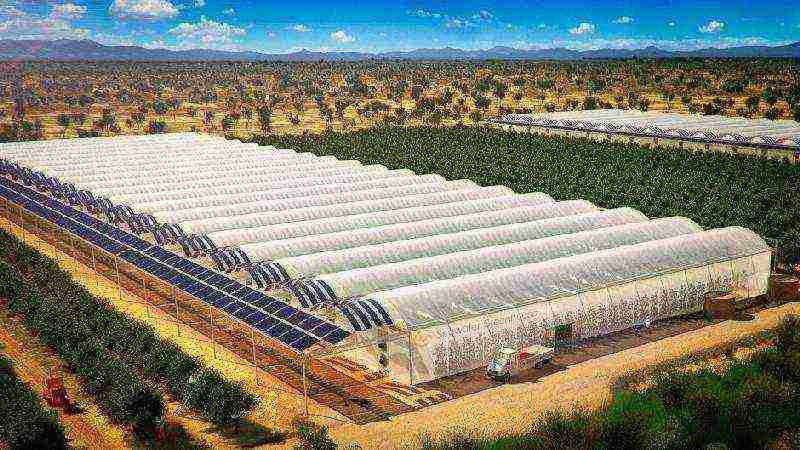
Where to start: a business plan for growing tomatoes in a greenhouse
Where to start:
- Choose a site for the future greenhouse. The best option would be the area where the vegetable-growing state farms were previously located. Since there are already prepared sites here;
- Register a legal entity by choosing the form of IE or LLC. A farm for which a single agricultural tax is paid is ideal. If future plans include selling tomatoes at retail or in public catering establishments, registration of a legal entity is required;
- Draw up a detailed business plan, taking into account future expenses and upcoming income.
REFERENCE: A business plan is needed in case of attracting co-investing partners, receiving a subsidy or a preferential bank loan.
How much can you earn?
The size of future profit depends entirely on a properly organized distribution channel:
- At the initial stage, you need to think about the subsequent sale of tomato products;
- Fresh tomatoes are constantly in price and are in great demand among the population;
- In winter, the cost of tomatoes increases significantly, there is practically no competition. This will allow concluding profitable contracts for the supply of vegetable crops;
- Wholesale is also possible - to supermarkets, restaurants, sanatoriums;
- Sell homemade tomatoes at an open point in the market.
Great business idea:
Required start-up capital
Growing tomatoes at an industrial size is not a very expensive business. At the very beginning, huge capital investments will not be required. The main costs will be land rent and greenhouse equipment. Self-construction of a greenhouse will greatly reduce costs.
When calculating future income, it is necessary to take into account all costs, both one-time and monthly. Costs include:
- Land lease;
- Registration of a legal entity;
- Construction and arrangement of a greenhouse;
- Purchase of planting material and fertilizers;
- Electricity and water costs;
- Paying taxes;
- Wages of hired workers;
- Packaging and labeling;
- Transport costs that deliver vegetables.

Some costs can be excluded:
- Land owners do not need to pay rent;
- Small greenhouses can do without maintenance staff;
- Branded packaging is required only for large farms with a registered trademark.
Approximate costs for one polycarbonate greenhouse of 100,000 sq. m start at 100,000 rubles. Of these, 10,000 rubles are needed for seed, at least 15,000 rubles for heating.
Land lease
To grow tomato crops, the land must be owned or leased. First you need to choose the appropriate place. The ideal choice is the countryside or countryside, close to nature and clean air.
ATTENTION: Similar farms are not desirable in close proximity in order to avoid competition.
Materials and equipment for the construction of a greenhouse
To build a strong greenhouse that will work all year round and give a rich harvest, you need to act in stages:
- Preparing a place for a greenhouse.
- Construction of the frame and fixing the base.
- Soil preparation.
- Creation of a heating, ventilation and irrigation system.
- Providing additional lighting.
Important issues related to business registration
Each type of activity must be registered. Before starting to grow tomatoes, legal registration is required. The choice of the form of activity:
- IP - if the land is owned;
- LLC - if in the future there are plans to create a large vegetable farm.
ATTENTION: In order to additionally store vegetables, it is necessary to obtain an appropriate permit from the sanitary-epidemiological and fire services.
Which varieties should you choose?
It is best to grow hybrid varieties in greenhouses, they are specially created for indoor use. When choosing the right variety, take into account:
- Productivity. Multi-fruited varieties significantly increase profits;
- Ripening period. A short growing season will make the business more profitable;
- Disease resistance. The best hybrid varieties do not infect pests and do not need constant insecticide treatment;
- Taste qualities of tomatoes. Fleshy fragrant fruits with a sweet taste are in great demand among buyers;
- Fruit size and color. Consumers prefer medium-sized tomatoes with deep red, pink or yellow color.
Tomato business. How much did I make from tomatoes:
The varieties selected must tolerate storage and transport perfectly. Popular industrial varieties of tomatoes for greenhouses:
- Early and mid-season varieties: Gift, Aksinya, Cherry, Evpator, Kostroma, Palenka;
- Hybrids with a shortened growing season: Verlioka, Rhapsody, Caspar, Sprinter, Etude, Farmer;
- Fruits with a particularly intense taste: Honey Spas, Pink Honey, Orange King, Asteroid, Lady, Ballerina.
REFERENCE: Professional vegetable growers usually grow no more than two or three types of tomatoes at a time.
Greenhouse tomato cultivation technology for sale
How to grow tomatoes:
- Seeds for seedlings are planted in February or early March in fertile soil, consisting of garden soil with compost and a small amount of sand. For them to germinate well, you need warmth, bright light and moderate watering;
- Feed seedlings with a solution of complex mineral fertilizers twice. Seedlings are planted in the greenhouse when at least 7 real leaves unfold on them;
- In order for tomatoes to grow well, they must be watered moderately with warm water, often ventilate the greenhouse and loosen the topsoil;
- The use of modern insecticides will help to save from pests, but use them before flowering begins. Treatment with medicinal products will save you from late blight. To avoid infection with root rot and black leg, you need to dust the soil with wood ash.
- For more formed ovaries, remove the lateral processes above 2 or 3 hands. Removing all deformed flowers and lower leaves will allow the fruit to ripen quickly.
How to grow tomatoes (tomatoes) in a greenhouse:
Growing tomatoes in a greenhouse as a business is quite profitable. A properly organized greenhouse is the guarantor of an excellent harvest. Its organization and operation is expensive, but with proper operation it will pay off within a year. A greenhouse built with quality materials does not need annual renovation. It will last for several seasons without any problems.
The main difference is that it is necessary to spend an impressive amount on the industrial cultivation of tomatoes in a greenhouse. If you are not ready to go for it, it is better to try to breed them on your own.However, it is worth remembering that this vegetable is very whimsical, and caring for it is rarely simple. If your financial situation allows you to use a modern greenhouse complex, then you can be congratulated, because in such a place you can harvest crops even for a whole year.
How to grow tomatoes in such premises? First you need to disinfect the ground and plant seeds for seedlings in advance. This point is key, because only with the right seedlings can you grow and harvest a good harvest. Thorough care, optimal temperature and uniform illumination - all this is the real key to success.
Do not forget about some general recommendations that must be strictly followed:
- Before planting, you need to prepare the soil. It should be porous and moisture permeable.
- Saplings should be tightly and securely tied, and also be at a certain distance from each other.
- From time to time, the bushes need to be formed by removing excess leaves and periodically tying up again.
- Remember that you always need to monitor humidity, temperature and systematic watering, even though such complexes have automatic systems.

Everything that is written above proves once again how important it is to take into account a huge number of factors in order to grow high-quality tomatoes.
Be careful, and have a good harvest!

